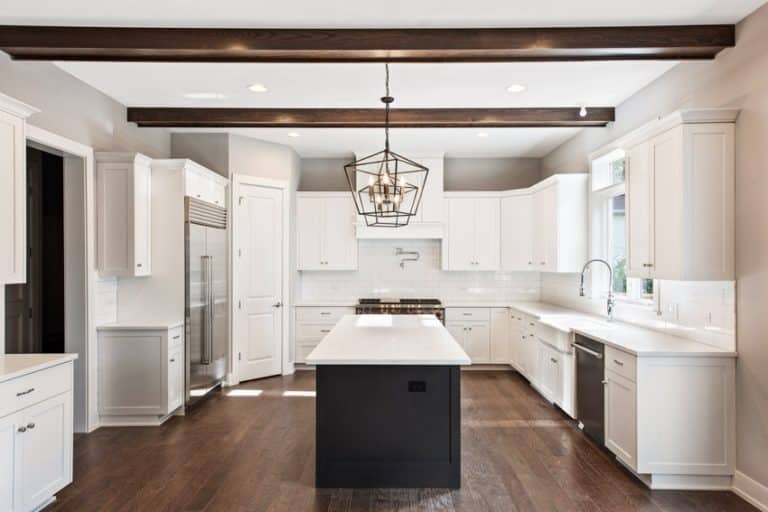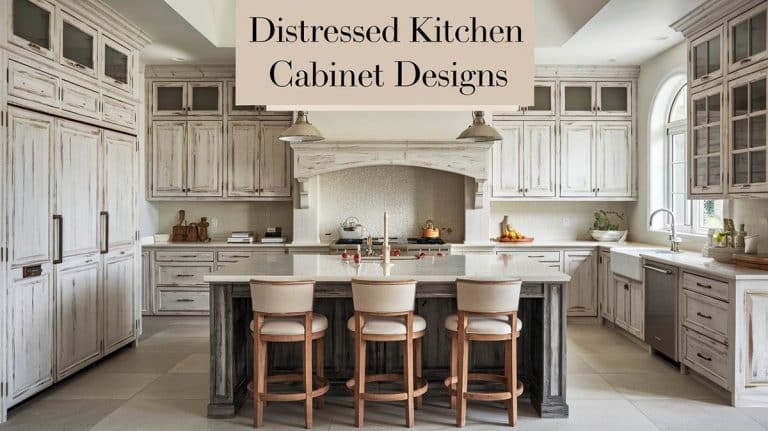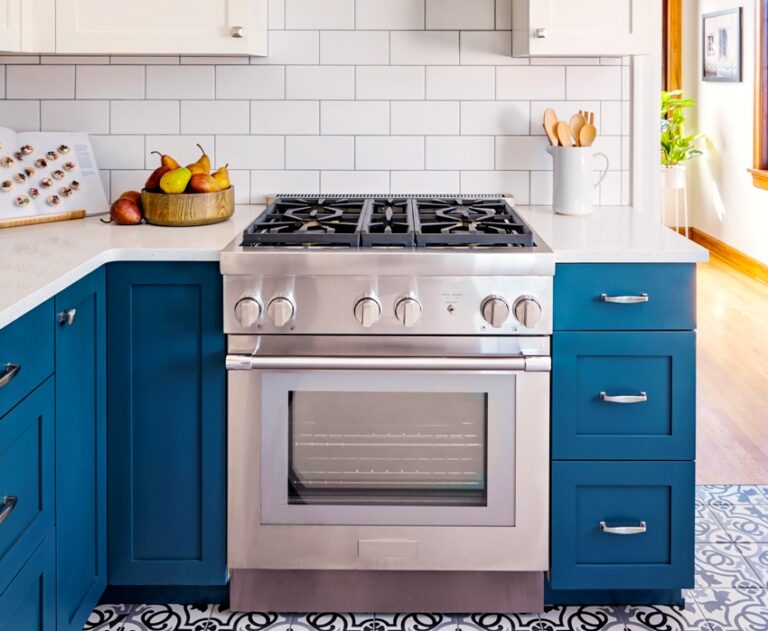Laminate Flooring In The Kitchen (Types & Benefits)
Laminate flooring is a widely recognized kitchen flooring pick- but why? Well, the primary reason why a lot of homeowners are going crazy about these floors is because they are quite stylish, moisture-resistant, durable, and cost-effective. But not just that – kitchen laminate floors are a ‘member’ of the most affordable flooring options you can encounter.
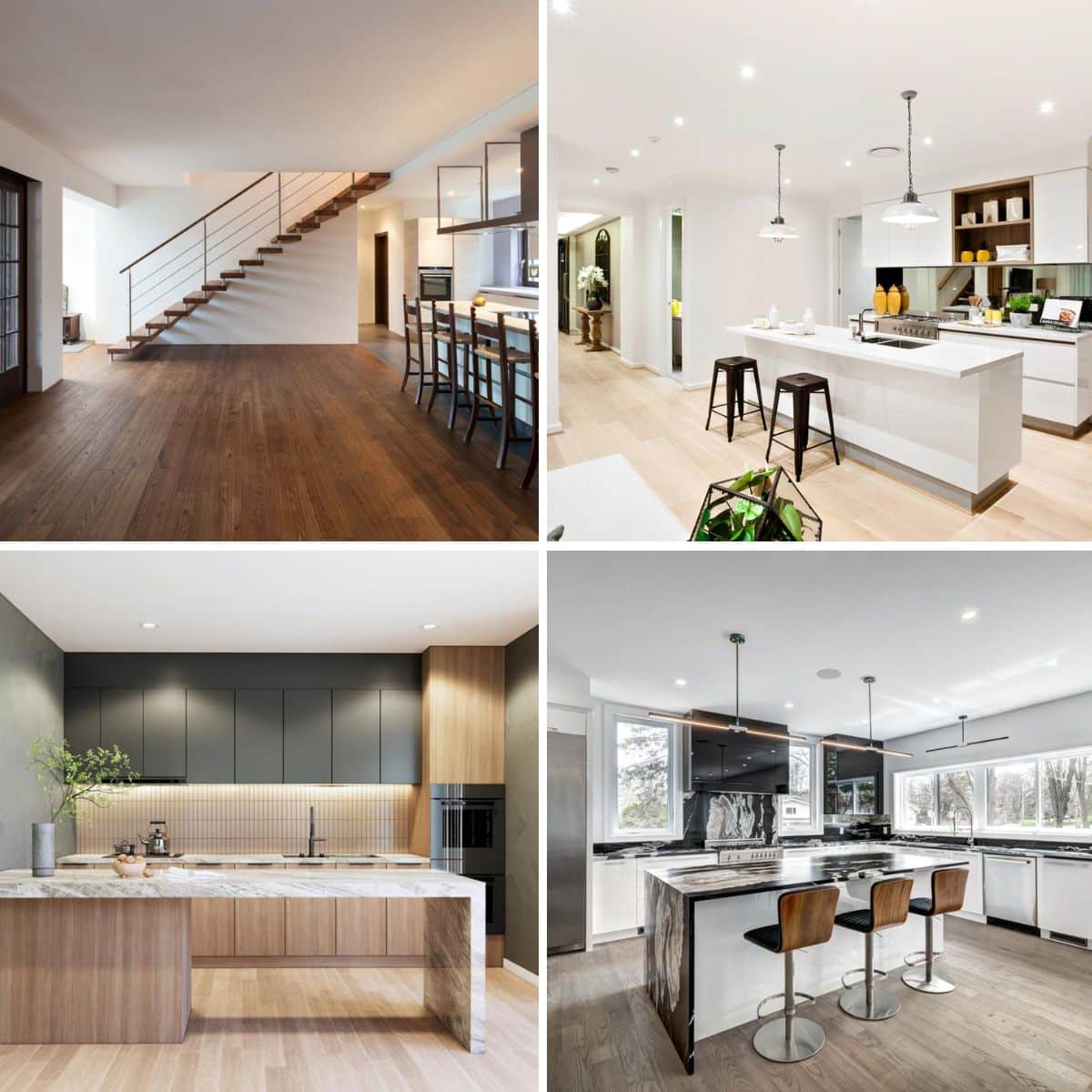
The aesthetic appeal and intrinsic elegance of stone or hardwood floors can be effortlessly imitated using laminate floors. Additionally, in high-traffic areas like your kitchen, they can be a competitive option. Nevertheless, the question here is, is this flooring the right pick for your beloved kitchen? Let’s find out.
Pros and Cons Of Laminate Floors In the Kitchen
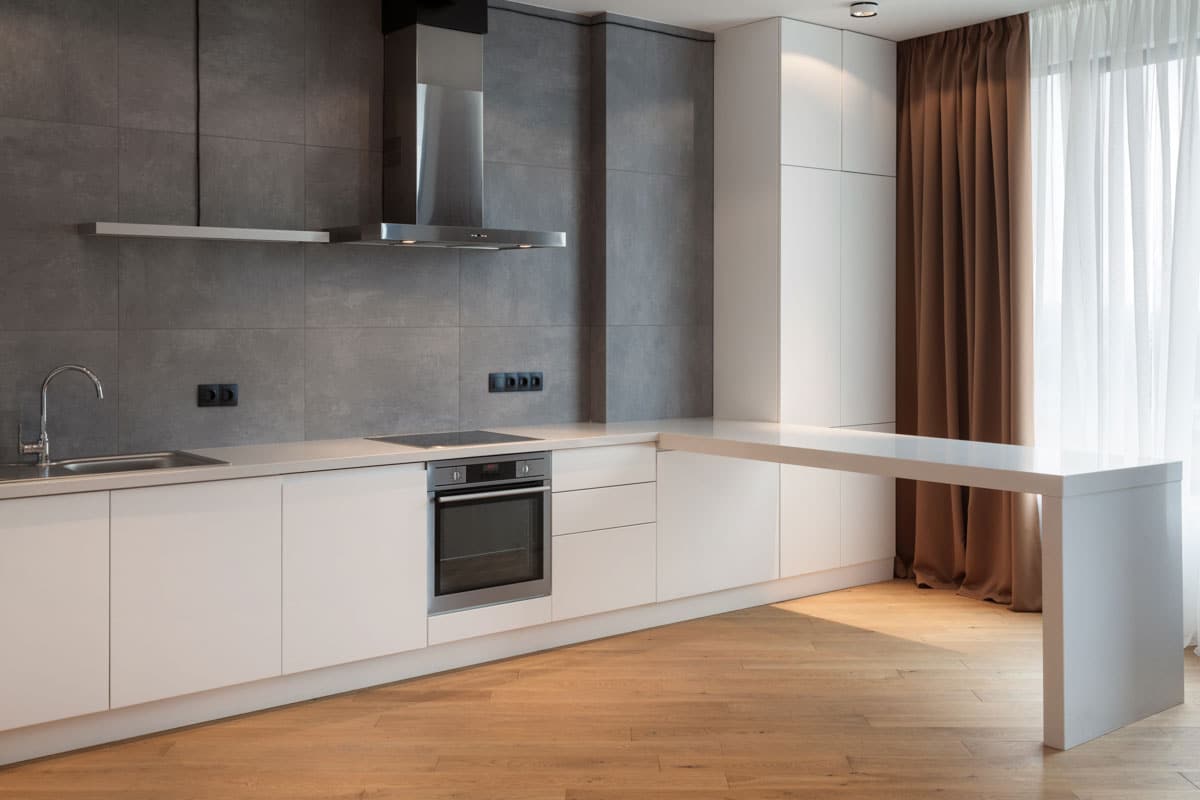
Pros:
Extremely Affordable: Laminate floors are appraised due to their affordability. With their utmost ability to replicate the appearance and other characteristics of natural wood or stone, there is no doubt that they are worth the purchase. On a tight budget and want to embark on a simple, low-cost kitchen renovation? Then go for these floors – it would be a wise decision.
Despite being affordable, laminates can still deliver you that much-needed ambiance and warmth that only natural materials can provide.
Remarkable Longevity: They are also reliable durability-wise. The multi-layered structure is the main contributor to its longevity and structural integrity. The topmost layer of these floors is customarily wear- and water-resistant, which can also effectively defend the surface from certain happenings we hate the most – fading, stains, dents, and scratches.
What makes laminates long-lasting? Interestingly, they rely on their remarkably durable core, the HDF (High-Density Fiberboard), whilst the melamine resin layering helps protect the surface against moisture damage.
The interlocking wooden planks, meanwhile, contribute to the total stability. Not only that but sometimes, such planks even feature anti-shifting properties. Aside from that, you can be sure that their surfaces are enriched with UV-resisting shields that can protect the kitchen flooring surface against sun-caused fading.
Available in a Vast Array of Styles and Designs: As indicated above, they can amazingly look like other natural flooring materials such as stone, ceramic, or hardwood. They are obtainable in a wide array of designs, colors, patterns, and styles.
Laminate flooring consists of a decorating plastic top surface bonded to a 1/4-in. core of particleboard or MDF. – The Kitchen Consultant: A Common-Sense Guide to Kitchen Remodeling By, Herrick Kimball
Whatever decor or theme you are hoping to accomplish – whether it is modern, minimalist, transitional, rustic, farmhouse kitchen flooring, or any style you can think of; they’re versatile enough to satisfy your style needs and preferences.
Uncomplicated and Quick Upkeep: Clearly, kitchens are in persistent contact with spills, messes, moisture, and other factors that may cause you to undertake tiresome cleaning and maintenance.
Fortunately, these floors, as aforementioned, have stain- and scratch-resistant properties. The result? Cleaning and maintenance become a fuss-free activity. By quickly wiping away spills and retaining a spotless surface, you can already attain a hygienic and tidy surface.
Ideal Flooring Option for Do-It-Yourselfers: Are you a do-it-yourself enthusiast? If yes, keep in mind that these floors can be your best friend as they offer a hassle-free placement and installation experience.
You can even find application options that have click-and-lock installation methods, which allows any DIYer to install them without enough construction expertise or skill.
Since installing these floors in your kitchen is achievable, this will allow homeowners to fully control their decisions when it comes to remodeling their kitchens. Due to this advantage, you can also save money as you do not need to hire an expert to do the job.

Cons:
Less Satisfying Feel and Sound: Although laminate flooring can be an expert imitator of natural flooring materials like hardwood or stone, it falls short of having that natural feel and sound. The surface may generate a ‘hollow’ sound as well as a not-that-comfy underfoot, which homeowners normally find in genuine hardwood or stone floors.
However, if you want to solve this issue, you can install additional underlayment materials to provide supplementary cushioning and sound-dampening properties.
Can Still be Damaged by Moisture: The topmost surface can be moisture-resistant, but if they are going to be in persistent contact with water (or the floors are always submerged in water), then these floors may not be able to survive and may lead to warping and swelling. So, if your kitchen is in constant contact with frequent spillages and leaks, this material may not be able to last long.
However, you can always prevent these damages if you are going to properly seal the edges and seams. You can also promptly clean every spill on the floor to immediately remove the moisture.
Does Not Offer Restorative Options: Unlike natural flooring materials like hardwood, which can be refinished or sanded to fix any flaws or signs of wear, laminates, when heavily damaged or worn, may have to be replaced. Yes, they do not have the same restorative options as hardwood floors in the kitchen. Replacing these floors may be a hassle and time-consuming, which is a major turn-off for homeowners.
May Contain Harmful Elements: Unfortunately, you can find laminates that may use few amounts of VOCs (Volatile Organic Compounds). Having such harmful elements may contaminate your indoor air and may induce health risks. Hence, when searching for products, make sure that you choose the eco-friendly ones to maintain the high-quality indoor air and eco-friendliness of your home.
May Not be Properly Installed Atop Uneven Subflooring: If your subfloor is uneven or simply not level, surfaces may be improperly placed, leading to certain concerns such as instability, early wear, and unwanted gaps. Thus, when installing laminate floors in the kitchen, ascertain that your subfloors are level.
Types Of Laminate Flooring
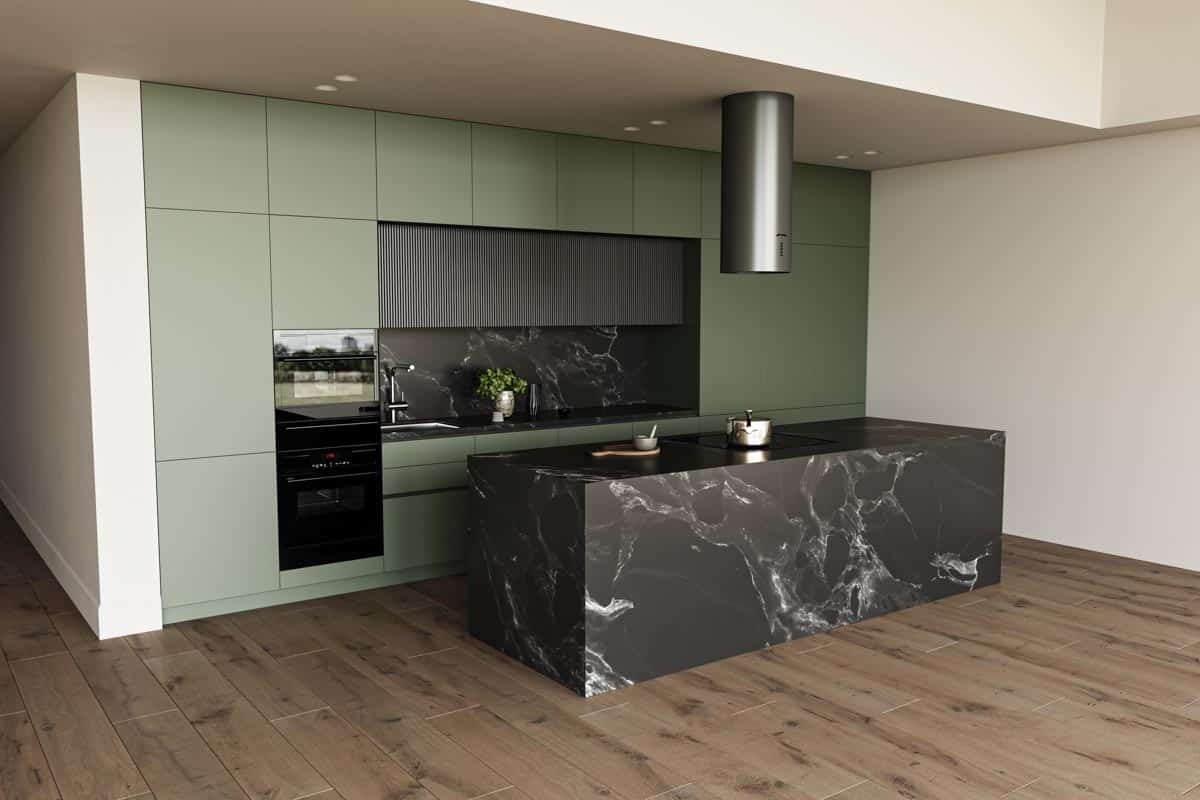
Laminate floors are not limited to one type only; they are available in various types, which can be used to match particular requirements and preferences:
Waterproof Laminate
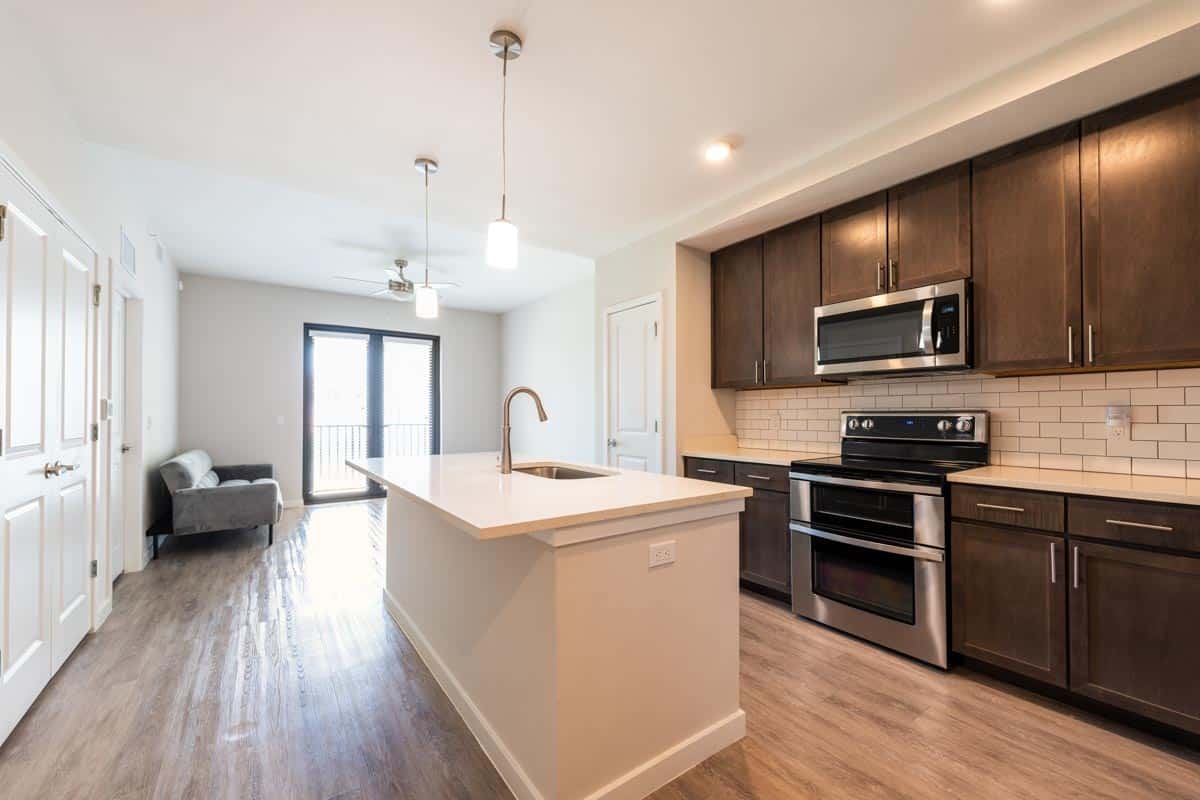
Waterproof laminate floors are your best bet when it comes to kitchen floors. As the name indicates, these are the exact opposite of conventional laminates – yes, these waterproof floors are engineered to endure any type of water damage.
So, if you wish to install hardwood or stone flooring in your kitchen because you want their natural elegance but not their moisture-shielding capabilities, you can choose waterproof materials instead. Just make sure that they have a realistic wood or stone appearance!
High-Gloss Laminate
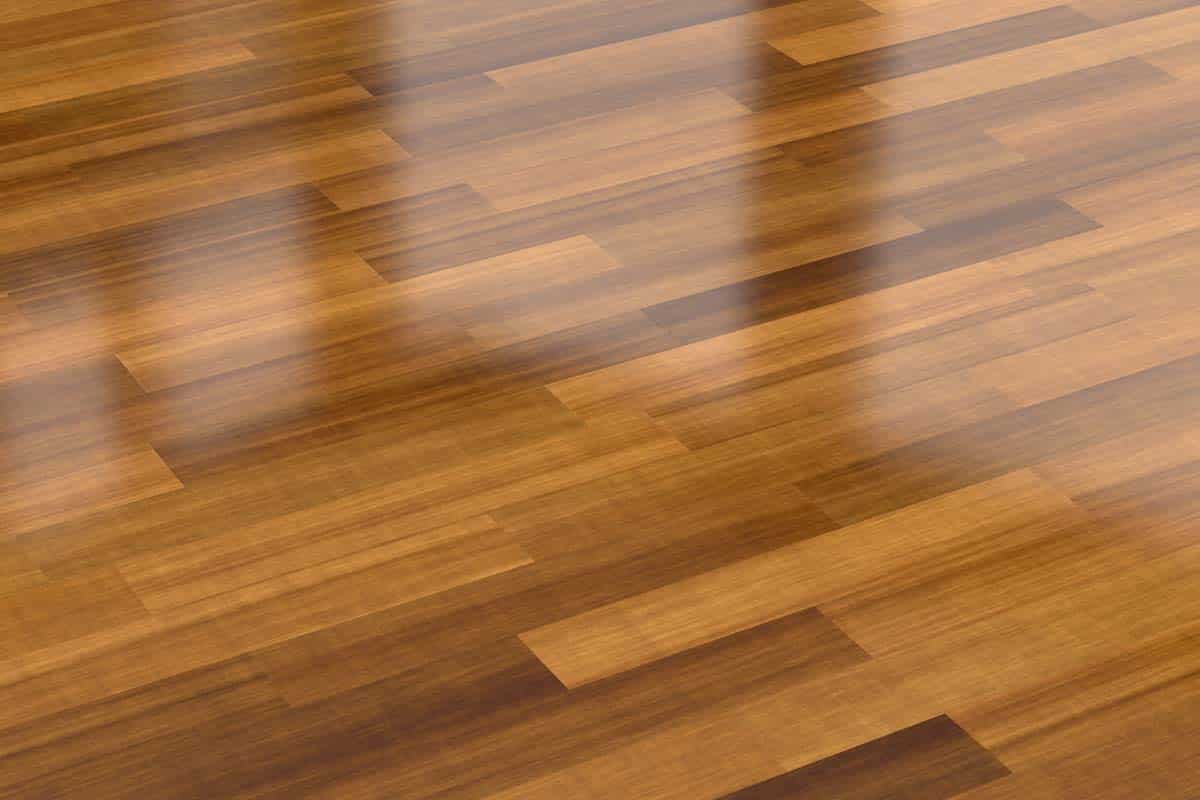
As the appellation states, high-gloss laminates are recognized for their reflective and glossy wood floor finishes. This type may be an ideal pick for kitchens that have a contemporary or modern theme.
Plus, if your kitchen is on the smaller side, take note that the reflective properties of high-gloss floors can help you make your kitchen space look more vibrant and expansive. While easy to clean, on the downside their high-gloss appearance can show smudges and dust more easily.
Hand-Scraped Laminate
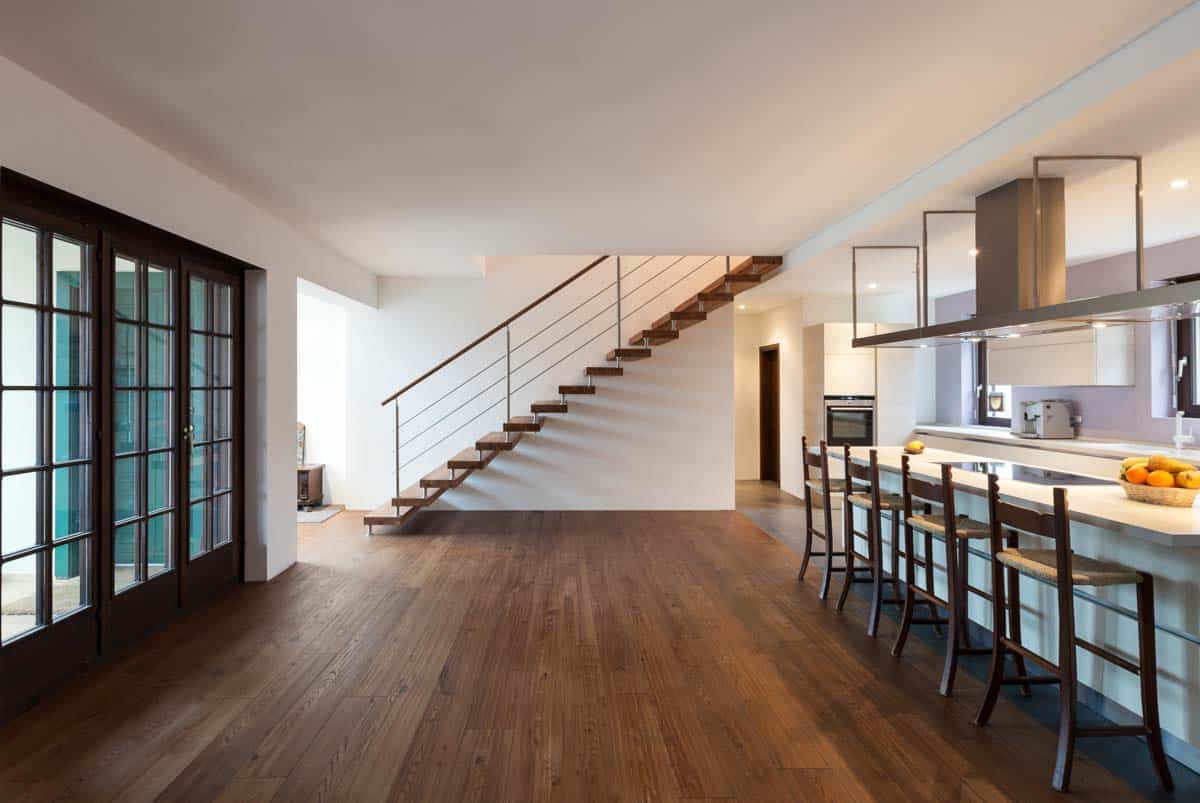
This type is the ultimate pick for hardwood flooring enthusiasts. Hand-scraped laminate is meticulously designed to imitate the genuine appearance of hardwood, which means it can add authentic rustic appeal and warmth to your kitchen.
Embossed-in-Register Laminate
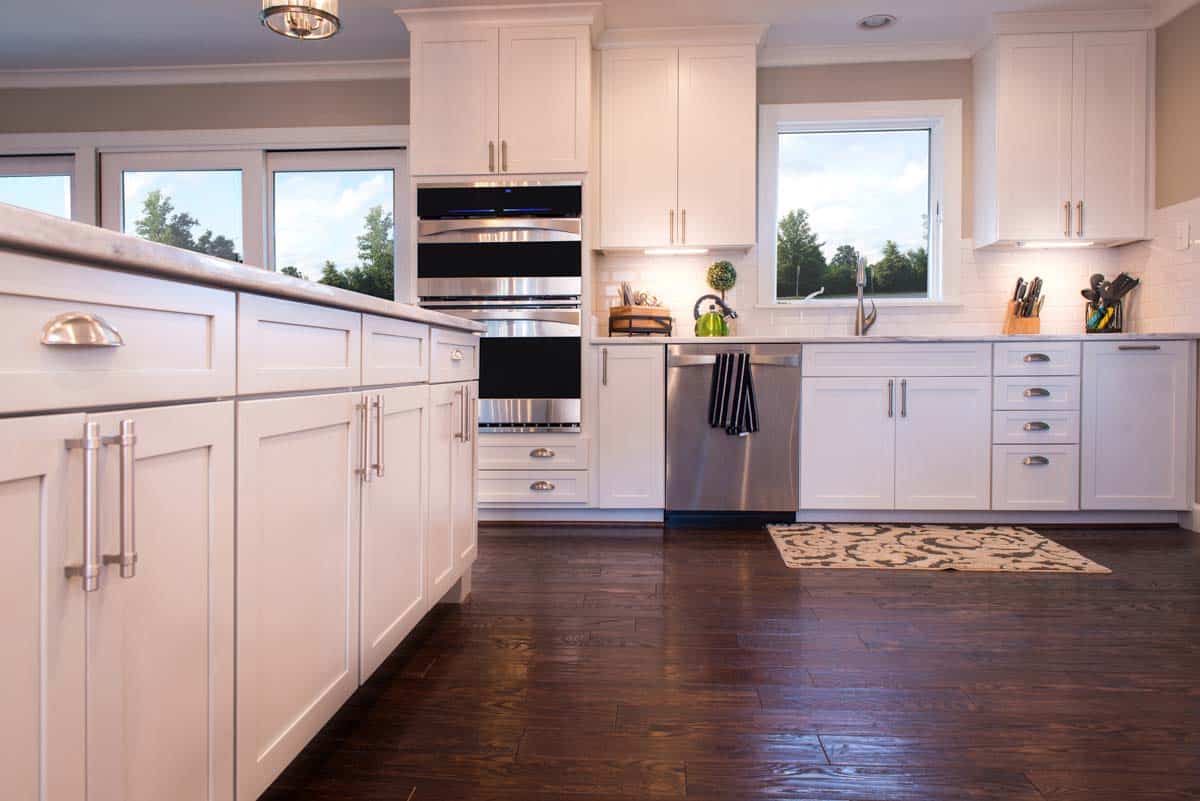
Embossed-in-register laminate, also known as EIR, is an advanced type of flooring that is expertly crafted to perfectly replicate other natural materials.
EIR laminates have that ultra-realistic appearance that fully resembles the grain patterns of natural hardwood or even the texture of stone. Furthermore, they are not just focused on mimicking the appearance of other premium flooring materials but also on capturing their tactile feel.
Distressed Laminate

For homeowners who are fond of having a vintage or weathered appeal in their kitchen, opting for distressed laminate would be the way to go. These distressed surfaces are artistically crafted to exhibit eye-catching flaws such as well-simulated scratches, wear, or weathered features.
Laminate Durability
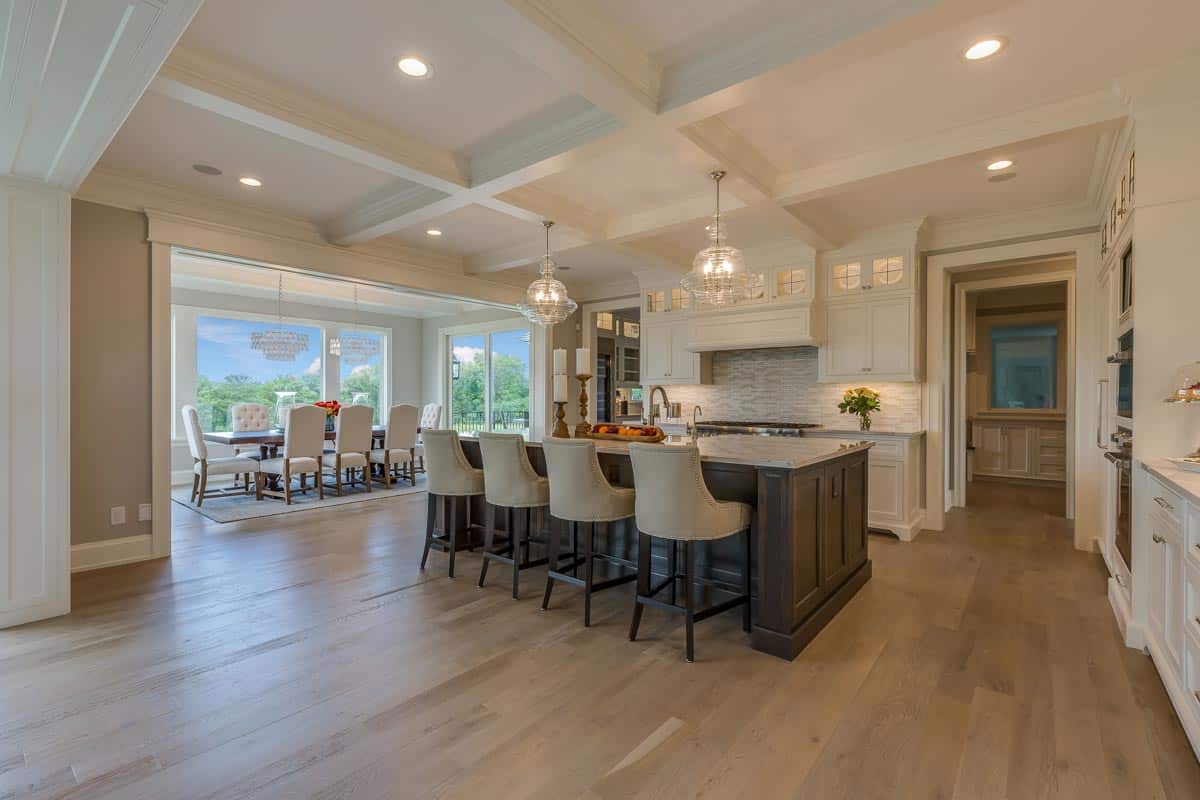
The durability of laminate floors is undeniable, making it a favorite choice for high-traffic locations like kitchens. The top surface is incredibly wear-resistant, henceforth allowing them to withstand heavy foot traffic, dropped utensils or cookware, or even pet claws.
Basically here are the 5 durability contributors of these floors:
• Multi-layered construction – wear layer, decorative layer, core layer, and backing layer
• Extreme wear resistance
• Enhanced moisture resistance
• High-density fiberboard
• UV-protecting properties
Nonetheless, if you want to ensure that you will be getting a highly durable and reliable flooring option for your kitchen, pick the ones that have an AC (Abrasion Class) rating. Remember, a higher AC rating means it has a higher durability level.
Laminate Maintenance
Ease of maintenance is among the most outstanding features of these floors. Here are some steps to clean and maintain them:
• Regular sweeping using a broom
• Routine vacuuming
• Occasional mopping using a damp mop
These are basically what you need to do consistently to ascertain pristine-looking kitchen floors. However, although most of these materials nowadays are water-resistant, it is still a wise idea to immediately wipe away any kitchen spills to prevent any potential damage.
Here are some things or habits that you have to avert when in the process of cleaning or maintaining your floors:
• Using excessive amounts of water while mopping (doing this may gradually damage the planks as time goes by)
• Placing heavy furniture directly on top (always insert rubberized pads under heavy kitchen furniture to avoid damaging the surface)
Laminate Cost
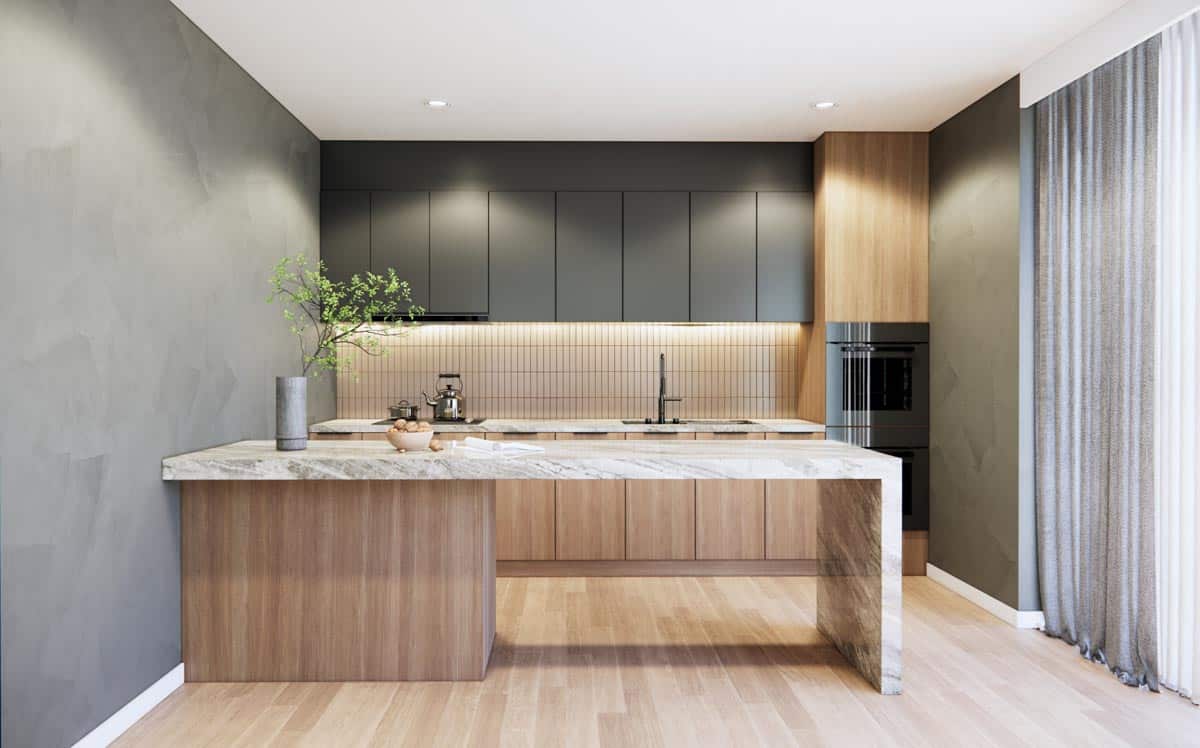
You can purchase laminate floors for as low as $300 or as high as $4,000 per standard-sized kitchen depending on the quality and labor costs.
- Types: Basic, Mid-Range, and Premium
- Cost per Square Foot: Ranges from $1 – $2 for Basic, $2 – $4 for Mid-Range, and $4 – $7 for Premium Quality
Laminates, as mentioned earlier, are a cost-effective and affordable flooring option for your kitchen. In general, the cost of installing per square foot is a lot cheaper compared to natural flooring options like marble, tile, or wood.
Even so, the cost may still vary as it will depend on the quality of the materials, complexity of the overall installation, underlayment process, extra labor materials, labor and contractor expenses, removal of existing floors, and the location of your house.
Installation Of Laminate Floors

Installing laminate is a relatively uncomplicated procedure. Here are some of the general steps you can undertake to accomplish a DIY installation:
1. Make sure the subflooring is level, clean, and fully dry. If your kitchen will be in persistent contact with water, you can insert a moisture barrier.
2, Get the kitchen’s dimensions; identify the layout and mark the starting points. You can also take into account the number of necessary planks.
3. Start laying down the most suitable type of underlayment and make sure that all of the seams are taped, glued, and staggered.
4. You may begin against a wall or in a corner and ascertain that the tongue side is facing away from the kitchen wall. You may use spacers.
5. Get the first set/row of laminate flooring planks clicked with the long edges and make use of a mallet and tapping block to achieve a snug fit. Start installing subsequent rows by linking the planks side-to-side as well as end-to-end.
6. When cutting planks, always use a saw to ensure precise cuts.
7. Mount any type of transition strip like reducers or T-moldings at the doorways or any place where the material meets other types,
8. Make sure to measure and cut the ultimate row to ensure a good fit. Leave an expansion gap against the kitchen wall. Lastly, you may attach quarter-round moldings or baseboards to conceal those expansion gaps around the perimeter.
Alternatives To Laminate
• Vinyl: This flooring option is popular for kitchens as it is also affordable, moisture-resistant, easy to maintain, and available in a broad selection of designs. However, they are often less durable than laminates.
• Engineered Wood: This alternative is made out of a real wooden surface and can be refinished, though it may sometimes be on the more expensive side. Wood is also troublesome in moisture-prone areas such as kitchens which could cause additional headaches with cleaning up and maintenance.
• Linoleum: This common and low-cost alternative is among those eco-friendly and easy-to-maintain kitchen flooring options. It is durable as well. However, the designs in this alternative may be limited and the color may fade over time.
See more related content in our article about laminate wood flooring in bathroom on this page.

